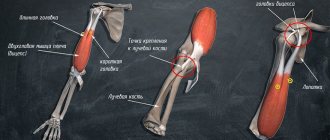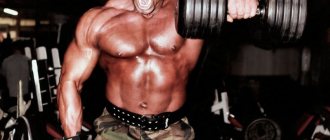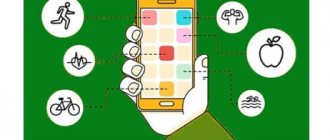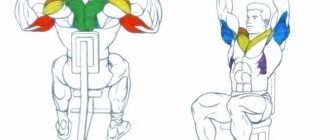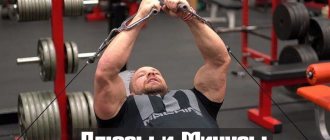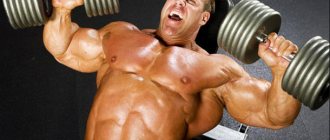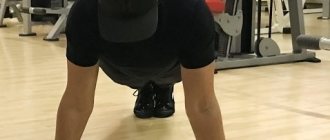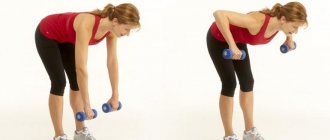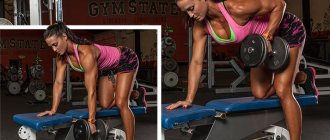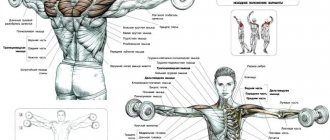Features and Benefits
First of all, you need to figure out which muscles work when performing this exercise. When lifting sports equipment, several groups are involved at once. Among them:
- shoulder;
- brachioradialis;
- anterior delta;
- center and top of trapezoidal;
- wrist flexors;
- biceps;
- levator scapula.
Some of the benefits of dumbbell curls include the following:
- The biceps brachii muscle is worked.
- Hands increase in volume.
- Increases strength and mass of the biceps.
- It is possible to get rid of muscle imbalance.
The variety of exercises using dumbbells for biceps is quite large. Each athlete can choose a suitable complex for himself. It is necessary to strictly adhere to technology and observe safety measures in order to achieve the desired result.
For girls who do not want to significantly increase the volume, shells with a small mass are suitable. In this case, it will be possible to increase the tone of your arms and visually tighten them.
Correct technique
It is important to figure out how to pump up your biceps at home correctly. The easiest way to understand this is by the technique of performing the exercise while standing. The training scheme is as follows:
- Feet are shoulder-width apart. Hands with dumbbells are turned towards the body. The arms are slightly bent.
- The position of the elbow joints is fixed by pressing them to the body. The abs tense.
- The arms slowly bend.
- The dumbbells are raised to shoulder level, but the hands are not pressed against the shoulder joints. Otherwise, the load on the muscle tissue will be partially reduced.
- At the top point there is a delay for a couple of seconds.
- Hands slowly drop.
When working out with dumbbells at home, you need to take into account several important nuances. It is strictly forbidden to use the force of inertia, perform jerking movements and twist the wrists back. If at the last repetitions there is no strength left at all, it is recommended to reduce the weight of the apparatus or reduce the number of movements in the approaches.
Exercise technique
Seated dumbbell raise
Supination is
Rotate the hand (forearm) around its own axis in such a way that the thumb moves away from the body and the little finger moves closer. Or it is the exact opposite of pronation. In almost all bodybuilding exercises, you will see how the hand turns specifically supinating at the peak point of contraction of the desired muscle.
Let's look at a graphical representation of hand supination.
When fighting on the arm wrestling table, you need to develop a strong supinating movement if you prefer to fight in a hook. Specifically, it correctly characterizes supination as a useful action. Remember how sometimes the enemy will sharply twist your hand into a lock and then begin to pull you along with him using the strength of his biceps and back, and it is supination that gives a very important jerk in such a movement.
Supination of the hand
In order to train specifically for this movement, you can use a block device. Look at the picture above. You attach a belt or towel to the block in such a way that only one end of it is taken into the brush (you can use a thick cable, more than 6 cm in diameter). It should be placed in your hand in such a way that it passes through the lower part hands (little finger). The movement phase itself begins from the moment you set your hand to a neutral position relative to the block. Usually this is perpendicular to the floor, and then your task is to twist your hand so that the little finger tries to spin as close to the body as possible. You will feel the load on your hand and lower fingers.
I recommend looking at this short article about hook wrestling.
I think you figured out what the supination movement of the hand or forearm is. Let's turn to a small summary of information from anatomy.
As such an instep support is a muscle group, these are all types of wrist flexors. Let's take a look at the picture; the so-called supinator, which is the opposing force to the pronator, is highlighted in a separate color. The supinator of the forearm is a muscle antagonist of the pronator. In general, any instep support in the muscular skeleton is a muscle or a group of muscles that is responsible for twisting one or another part of the body. But there are also general concepts, for example:
Biceps supination
This is actually the same supination of the hand, while simultaneously contracting the biceps. Why then is this almost mirror movement called separately biceps supination? Let's figure it out. The muscles of the forearm (hand) are tightly connected to the muscles of the shoulder (biceps), and specifically the attachment of the biceps muscle on the side of the hand is located under the pronator teres of the forearm. And as a result, in joint twisting there is a rather strong synergistic effect from joint work - greater supination of the biceps than if this movement was with an isolating moment. In other words, if we did not twist the hand, then there would be no supination of the biceps or it would be small.
Creator - IvanM
Variations of the exercise
It is worth noting that exercises with dumbbells can be performed in several ways. Each of them has a number of features. Although the principle remains the same, the execution technology is still different. Accordingly, the training program will also vary.
With emphasis on the thigh
This exercise will help to quickly pump up muscle tissue. Its peculiarity lies in the fact that even projectiles with a large mass can be used. This is due to the fact that the elbow is securely fixed, resting on the thigh. Lifting impressive weights becomes as safe as possible. The following actions are performed:
- The athlete sits on a bench, spreading his feet and resting his feet on the floor for maximum stability.
- Take a dumbbell in one hand.
- The body leans forward slightly, but the back continues to remain straight.
- The elbow rests on the inner thigh. It should be slightly bent.
- The second limb is placed with the palm on the knee or thigh of the second leg.
- A shoulder press is performed and the apparatus is held in this position for a couple of seconds.
All that remains is to return to the starting position and perform the required number of repetitions. Then the projectile is transferred to the second hand. The exercise is done again with strict adherence to the instructions and thus the other biceps is pumped up with dumbbells.
Lying on an incline bench
Unlike standing dumbbell curls, the target muscle tissues are initially already in a stretched position. You can pump them up on an inclined bench. You need to do the following:
- Raise the back of the bench so that it is positioned at an angle of 45 degrees.
- Take the equipment and sit on the prepared bench.
- Turn your palms toward your body and bend your elbows slightly.
- Use your muscles to fix your elbows.
- Take your time and lift the dumbbells as slowly as possible.
- When a right angle is reached, hold for a few seconds.
- Return to original position.
It is unacceptable for hands with projectiles to hang on the sides of the body. Otherwise, you will not be able to perform the biceps exercise correctly.
Reverse grip and “Hammers”
Among the effective exercises for biceps and triceps are hammers with dumbbells, as well as lifting equipment with a reverse grip. They can be performed both from a sitting and standing position. The underlying technology should be considered. When using a reverse grip, you need to do the following:
- Take dumbbells in your hands.
- Place the projectiles approximately shoulder width apart.
- The elbow joints must be pressed against the torso.
- Bend the brush slightly.
- Perform a smooth lift of the dumbbells, accompanying this movement with exhalation.
- Slowly lower the projectile while inhaling.
The biceps hammer exercise provides an isolated load. If it is not felt, then some mistakes have been made. The following scheme should be followed:
- Take the shells and hold them parallel to the body. The back should be straight. Elbows are placed as close to the ribs as possible.
- The arms are bent and both dumbbells are raised at the same time.
- When performing the hammer exercise with dumbbells, your arms are bent until a right angle is reached between the biceps and forearm.
- There is always a pause at the top, after which there is a smooth return to the starting position.
Hammers can also be made in several variations. For example, doing dumbbell curls while standing, sitting and on a bench. Depending on which option is chosen, the number of support points varies. Perhaps, when performing a specific exercise for the arms with hammer dumbbells, it will be much easier to leave the body motionless.
Hammer grip
Supination
Standard exercises with dumbbells at home allow you to work only certain areas of the biceps. There is no load on absolutely all muscle tissues. True, it is still possible to achieve the desired result. For this purpose, dumbbell curls for biceps are performed with supination. By changing the position of the hand and turning it towards you, the shoulder muscles are also included.
These actions must be performed strictly according to the rules. Turns are carried out only at the moment when the angle at the elbow reaches 90 degrees. Otherwise there is a risk of injury. The wrists are rotated to their original position even before the hands are down.
Seated dumbbell raise
Lifting dumbbells for biceps while sitting is practically no different from exercises in a standing position. For training, you need to find a flat surface about 45 centimeters high, ideally an ordinary bench for bench press. At home, you can use an ordinary stool, and in the hall, any horizontal surface, the main condition is the free movement of the arm from a straightened position to a half-bent one.
The correct technique for performing dumbbell curls in a sitting position:
- straight back;
- straightened shoulders;
- legs bent at right angles;
- arms are straightened and freely lowered along the body;
- as you inhale, the hand raises the dumbbell to chest level, and as you exhale, it lowers to the starting position.
It is necessary to choose the optimal weight. The exercise is contraindicated for athletes who have not yet recovered from injuries to the elbow joint. Important! Lifting dumbbells for biceps while standing and sitting with supination has an important aspect. If you rotate your hand while lifting, you need to grip the dumbbell in a special way. The projectile is taken by the bar not exactly in the middle, but with an offset towards one weighting material, so that the thumb is pressed against the pancakes. The dumbbell bar, as a rule, is long enough so that in the position described above there is a distance of several centimeters between the little finger and the weight plate. This grip allows you to train without undue effort. Alternate lifting is a great way to pump up your arms with dumbbells. If you lift dumbbells at the same time, you can become exhausted very quickly. Another possible variation is to do 10 reps with one arm, followed by a second set of 10 reps in a row with the other arm. Alternate lifting is still the best option.
Incorporation into a training program
It is important to properly develop a biceps training plan. If the main goal is to increase its volume, then just lifting the shells will not be enough. The complex also includes barbell lifts using a reverse grip.
For men just starting to master bodybuilding, as well as girls, it is recommended to start training with light weight equipment. Once the technique has been mastered, you can gradually increase the load by increasing the weight.
To pump up your biceps, it is enough to perform up to 4 approaches with a maximum of 12 repetitions each. In order to increase efficiency and stimulate blood circulation, it is recommended to stretch the muscle tissue after each approach.
It is also worth considering that not everyone can perform biceps exercises. There are a number of contraindications to such physical activity. For example, with injuries to target groups of muscle tissue, with inflammatory and degenerative processes in the wrist and elbow joints. Such physical activity, if contraindicated, can cause significant harm.
It is enough to include up to 4 approaches to a maximum of 12 repetitions each in your workout.
Beginners should choose light weight equipment to perform the exercise.
